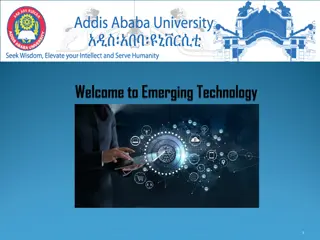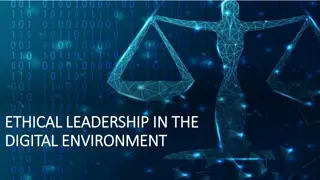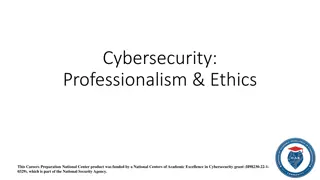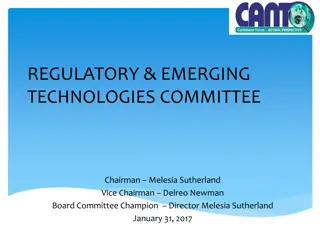Understanding Ethics and Professionalism in Emerging Technologies
Explore the intricate relationship between ethics and technology, focusing on the importance of integrity, objectivity, competence, confidentiality, and professional behavior in the accountancy profession. Delve into general ethical principles, professional responsibilities, and leadership principles essential in navigating the challenges and responsibilities associated with emerging technologies.
Download Presentation

Please find below an Image/Link to download the presentation.
The content on the website is provided AS IS for your information and personal use only. It may not be sold, licensed, or shared on other websites without obtaining consent from the author. Download presentation by click this link. If you encounter any issues during the download, it is possible that the publisher has removed the file from their server.
E N D
Presentation Transcript
Chapter Six ETHICS AND PROFESSIONALISM OF EMERGING TECHNOLOGIES
Learning outcomes After completing this lesson you should be able to Distinguish the link between ethics and technology. Understand general, professional and leadership ethical questions. Explain what digital privacy is, its components and why it is important. know the importance of accountability and trust in emerging technologies. Identify the threats and challenges we face in developing and utilizing emerging technologies.
From your civic and ethical education course, what do you understand about the word ethics? Ethics is particularly important for the accountancy profession, with a code for professional ethics based on five basic principles Integrity Objectivity Competence and due care Confidentiality Professional behavior
General ethical principles 1.Contribute to society and to human well-being, acknowledging that all people are stakeholders in computing. 2. Avoid harm. 3. Be honest and trustworthy. 4. Be fair and take action not to discriminate 5. Respect the work required to produce new ideas, inventions, creative works, and computing artifacts. 6. Respect privacy. 7. Honor confidentiality .
Professional responsibilities 1. Strive to achieve high quality in both the processes and products of professional work. 2. Maintain high standards of professional competence, conduct, and ethical practice. 3. Know and respect existing rules pertaining to professional work. 4. Accept and provide appropriate professional review. 5. Give comprehensive and thorough evaluations of computer systems and their impacts, including analysis of possible risks.
Professional responsibilities 6. Perform work only in areas of competence. 7. Foster public awareness and understanding of computing, related technologies, and their consequences. 8. Access computing and communication resources only when authorized or when compelled by the public good. 9. Design and implement systems that are robustly and usably secure.
Professional leadership principles 1. Ensure that the public good is the central concern during all professional computing work. 2. Articulate, encourage acceptance of and evaluate fulfillment of social responsibilities by members of the organization or group. 3. Manage personnel and resources to enhance the quality of working life. 4. Articulate, apply, and support policies and processes that reflect the principles of the Code.
Professional leadership principles 5. Create opportunities for members of the organization or group to grow as professionals. 6. Use care when modifying or retiring systems. Interface changes, the removal of features, and even software updates have an impact on the productivity of users and the quality of their work. 7. Recognize and take special care of systems that become integrated into the infrastructure of society.
Digital privacy Digital Privacy is the protection of personally identifiable or business identifiable information that is collected from respondents through information collection activities or from other sources. Three sub-related categories Information privacy Communication privacy Individual privacy
Contd.. Information privacy : The notion that individuals should have the freedom, or right, to determine how their digital information, mainly that pertaining to personally identifiable information, is collected and used. Communication privacy :The notion that individuals should have the freedom, or right, to communicate information digitally with the expectation that their communications are secure. Individual privacy: The notion that individuals have a right to exist freely on the internet, in that they can choose what types of information they are exposed to, and more importantly that unwanted information should not interrupt them.
Some digital privacy principles Data Minimization: collect the minimal amount of information from individuals and businesses consistent with legal requirements. Transparency: Collection and use of identifiable information will be provided in a clear manner and mandated by law. Accuracy: Information collected will be maintained in a sufficiently accurate, timely, and complete manner. Security: Adequate physical and IT security measures will be implemented to ensure that the collection, use, and maintenance of identifiable information.
Accountability and Trust The challenge is exacerbated by the speed at which technological change is occurring and the breadth of its adoption which is introducing new risks that demand new responses. Emerging technologies can provide improved accuracy, better quality and cost efficiencies for businesses in every sector. They can enhance trust in the organization s operations and financial processes, which is crucial for sustainable success.
Threats and Challenges Ethical and regulatory challenges: 1. Counter-terrorism and law enforcement informatics via predictive analytics and artificial intelligence. 2. Real-time horizon scanning and data mining for threats and information sharing. 3. Automated Cyber security and information assurance. 4. Enhanced Surveillance (chemical and bio-detection sensors, cameras, drones, facial recognition, license plate readers). 5. Simulation and augmented reality technologies for training and modeling.
Contd. 6. Safety and security equipment (including bullet and bomb proof) made with lighter and stronger materials 7. Advanced forensics enabled by enhanced computing capabilities (including future quantum computing) 8. Situational awareness capabilities via GPS for disaster response and crisis response scenarios 9. Biometrics: assured identity security screening solutions by bio-signature: (every aspect of your physiology can be used as a bio-signature. Measure unique heart/pulse rates, electrocardiogram sensor, blood oximetry, skin temperature) 10. Robotic Policing (already happening in Dubai!)
Challenges in using Artificial Intelligence AI is only as good as the data it is exposed to, which is where certain challenges may present themselves. AI is its potential to replace human workers. As machines become more intelligent they could begin to replace experts in higher-level jobs. AI also has the potential to take the burden of laborious and time- consuming tasks from these people, freeing up their time and brainpower for other things.
Challenges in using Robotics in manufacturing With automation and robotics moving from production lines out into other areas of work and business, the potential for humans losing jobs is great here too. As automation technologies become more advanced, there will be a greater capability for automation to take over more and more complex jobs. As robots learn to teach each other and themselves, there is the potential for much greater productivity but this also raises ethical and cybersecurity concerns.
Challenges in using the Internet of Things As more and more connected devices (such as smart watches and fitness trackers) join the Internet of Things (IoT) the amount of data being generated is increasing. Companies will have to plan carefully how this will affect the customer- facing application and how to best utilize the masses of data being produced. There are also severe security implications of mass connectivity that need to be addressed.
Challenges in Big Data Almost all the technologies mentioned, have some relation to Big Data. The huge amount of data being generated on a daily basis has the potential to provide businesses with better insight into their customers as well as their own business operations. Although data can be incredibly useful for spotting trends and analyzing impacts, surfacing all this data to humans in a way that they can understand can be challenging. AI will play a role here.
Some risks of emerging technology: Driverless car: while a compelling option for future fleer cars, companies could crash and burn from claims related to bodily injury and property damage. Wearables: Google glass, Fitbit and other wearables can expose companies to the invasion of privacy claims that may not be covered by general liability or personal injury claims that weren t foreseen.
Some risks of emerging technology: Drones: Turbulence is in the offing for manufacturers and organizations that fail to protect themselves for property damage and bodily injury, as well as errors and omissions. Internet of things: The proliferation of sensors and cross-platform integration creates potential exposure from privacy invasion, bodily injury and property damage that may connect an organization to huge liabilities.























